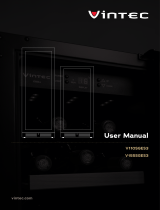
14
INTRODUCTION TO WINE
Wine storage
As is well-known, wine can be stored over time: if
kept in a suitable place, white wines can be stored for
about two years from their vintage date, however it
is best to consume them within one year. Light red
wines can be stored for up to two years, whereas
some full-bodied red wines will keep will for ten
years and dessert wines even twenty years.
When purchasing a bottle of wine, immediately put
it in your wine cellar or another suitable place.
There are three all-important factors in the process
going from grape growing to harvesting and
vinification: light, humidity and ambient
temperature. To ensure that the taste of the wine
reaches full maturity and to preserve the bouquet,
proper storage is necessary through the interaction
of these three factors.
Storage place
Not everyone has a basement suitable for use as a
cellar. Technology has only recently provided an
effective substitute for the classic cellar. Your new
wine cellar is a special appliance specifically designed
to hold and store wines properly. In fact, it should only
be used for your favourite bottles of wine, and not for
fruit, vegetables and tins. In this way, you can suitably
age, store and taste any kind of wine, even if you do
not have a cellar space.
Storing
A golden rule for storing your wine bottles is to lay
them horizontally or tilted to ensure that the wine
keeps the cork wet. Many think that this causes the
classic smell of “cork”. In actual fact, keeping the
cork in contact with the wine enhances its elasticity,
thereby guaranteeing its functionality.
Another important factor in storing wine is how the
bottles are arranged: the bottles should be
arranged freely but in an orderly way according to
place of origin, type of wine, production area,
producer and vintage, also using the cataloguing
labels provided. Arranging the bottles so that they
can be easily removed and used prevents any
accidental jolting which, like vibrations, can unsettle
the sediments and alter the visual appearance of the
wine for some time. Therefore, move your bottles
as little as possible, allowing the wine to rest. Do
not push the bottles against the rear wall of the
cellar as this will not only compromise efficient
defrosting, but could also ruin the bottle labels due
to the water droplets collected during defrosting.
Bottle racks must be made from wood, as this
material effectively absorbs any vibrations and keeps
bottles away from the wall which transmits heat or
cold.
Also, the bottles of wine must be stored away from
substances or places with strong odours, which can be
easily absorbed by the wine. Therefore, your new
appliance has an active carbon filter to absorb any
impurities in the air.
Temperature and humidity
Temperature is a critical and vital factor during the
entire life-cycle of wine; it determines how well the
wine develops when aged in the bottle. For optimum
storage, the temperature must be kept constant
between 8 and 12°C. Rapid and considerable
temperature changes must be avoided: when the
temperature is too high, the liquids expand,
accelerating the ageing process, whereas excessively
low temperatures (below 4 - 5°C) can cause tartrate
precipitations, a defect that compromises the pleasant
appearance of the wine. In the extreme case of the
temperature falling below 0°C, the wine would freeze
causing the cork to burst
Humidity is also crucial for good storage: dry places
cause the cork to shrink, whereas too damp places
cause mould and harmful microorganisms to form.
The relative humidity must be kept between
50% - 70%.
The cork
The cork is a basic component of the bottle: its quality,
selected by the wine-maker, is very important for
correct ageing of the wine. The perfect conditions of the
cork, including corks of the bottles purchased, depend
exclusively on the standards of use and storage
employed by the producer or bottler.
31102009GB.fm Page 14 Monday, October 23, 2006 12:29 PM









